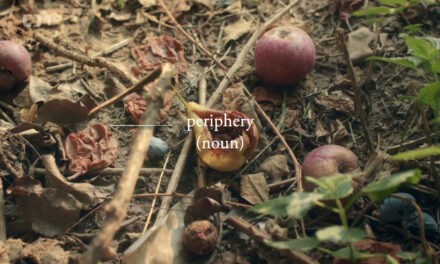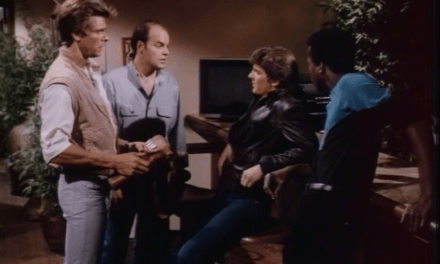(A re-introduction to the Eye tracking the Moving Image Research Group)
![]()
I have a painterly confession to make. When I saw eye tracking visualisations for the first time they flooded me with affecting impressions. They seemed to float outside, or ignite the air, of the computer screen I was witnessing them on. These vibrant visualisations threw light particles onto the surfaces all around me. I felt them as arrows and spirals and galaxies of light, colour, and intensities. The very last thing on my mind was scholarship – how useful they might be for empirical research of the moving image – that came later.
I saw these dynamic eye-maps as irregular and chaotic blocs of sensation; carriers of embryonic stories, histories and memories; and conveyors of feeling – the mind’s eye delicately locked into these beautiful incandescent streams and flows. I saw them as phenomenal art pieces and I saw their potential in creative practice. I imagined them projected onto reflective edifices, tenement walls and abandoned buildings; on display windows and mirrors; in installations and exhibitions; and on the silver screen in opulent cinemas.
When I first stared in awe at eye tracking visualisations it was through the poetry of aesthetics and the sediments of love. This is what I saw:
Luminance
Luminosity
Spirals and Contours
Regular and Irregular Flows of Time and Space
Haptic Maps
Phenomenal Biology
Taste sensations
Poetry of the Eye;
Visual
Art….
LiQuId LoVe
I saw these visualisations as akin to poetry and in particular, to the God particles that illustrate many of Blake’s best poems:
Tyger! Tyger! burning bright,
In the forests of the night;
What immortal hand or eye,
Could frame thy fearful symmetry?
In what distant deeps or skies.
Burnt the fire of thine eyes?
On what wings dare he aspire?
What the hand, dare seize the fire?
And what shoulder, & what art,
Could twist the sinews of thy heart?
And when thy heart began to beat,
What dread hand? & what dread feet?
I saw eye tracking visualisations as expressions of cosmology, a re-arrangement of the planets and stars – the quivering stuff we are made of.

Van Gogh, Starry Night
I saw them as lunar canvasses and exploding meteors:



![]()
Sasha Archibald: Ilya Repin’s painting, An Unexpected Visitor [1884]
Eye Tracking Creative Practice
The Eye Tracking and Moving Image Research group was set up to establish film, sound and art making practices in and around the light dances that the visual data from eye tracking offered us. The group will employ eye tracking in screenplay writing; public art projects (installations, projections, exhibitions, pop-ups); filmmaking; and in and through the way that music is visualised.
This interdisciplinary group crosses what it sees as the porous divisions between theory and practice. See Sean and Jodi Sita’s blog here that more fully outlines the group’s formation, and aims and ambitions).
Under a broad umbrella a small number of us have begun to tentatively coalesce under a bio-art conceptualisation: drawing upon Frances Stracey, we consider bio-art to represent ‘a crossover of art and the biological sciences, with living matter, such as genes, cells or animals, as its new media’. However, we extend this definition to include the skins and cells of celluloid and video, the membranes of sound, and the liquids and fluids of body parts and eyeballs.
The qualities of liquid and liquidity have become one of our key metaphors and ‘substances’ with which to make artistic sense of eye tracking visualisations. Our first project, presently in development, is born out of such watery substances and the contrasting heat of romantic love. This is a project fashioned out of liquid love.
Liquid Love

Title of Proposed Work: Liquid Love
Artists: Richard Grant, Sean Redmond, Darrin Verhagen, Nick Verso
Conceptualization:
In a liquid modern life there are no permanent bonds, and any that we take up for a time must be tied loosely so that they can be untied again, as quickly and as effortlessly as possible, when circumstances change – as they surely will in our liquid modern society, over and over again.
Zygmunt Bauman (2000)
The representation of romantic love has a long tradition in art. However, writers such as Sygmunt Bauman and Lauren Berlant have argued that in this age of ‘togetherness dismantled’, love has been given a liquid quality and emptied of its deeper signification. In fact, since the rise of modernism, artists including Egon Schiele, John Brack, Edward Hopper, and Tracy Emin have questioned romantic love. When it comes to eye tracking research, it has been argued that eye movements may reveal if a person is feeling romantic love or sexual desire. However, the possibility of finding and capturing romantic love still occupies a central place in the artistic canon, with the tearful encounter between Marina Abramovic and her ex-lover a particular inspiration for the piece we are proposing to make. In this work we want to represent not only how lovers look at one another, but the aesthetic quality of these looks, longings, and glances.
Questions and Themes
How do people who are in love stare at one another?
Is there a difference between the way new lovers look at one another and those who have been in love for a long time?
Is love Liquid?
Finding, searching for romance in the heat of such visualisations
Love in the art of eye tracking
The Work
A two-panel/screen installation or an exterior projection onto a building/ wall/ façade that involves projecting the visual data (heat and contour maps, gaze patterns, gaze swarms) collected from eye tracking two separate encounters between two people romantically involved.
The first encounter will be between two people experiencing ‘new love’. The second encounter will involve two people experiencing ‘lived-in love’.
These ‘meetings’ will take place against two or more romantic backdrops and in two or more romantic contexts. They will be filmed twice; firstly, with the lovers meeting each other ‘naturally’; and second, with them meeting wearing the eye tracking glasses that will produce the visual patterns that will become a central part of the art work.

The projection will be composed of the naturally filmed footage and the visual data produced by eye tracking their encounter.
The footage and data will be edited so that the glasses are removed from the work, so that the lovers appear to be creating these patterns as they look at one another.
The projection will also have an affective sound design. Sound will rise and fall from one encounter to the next, and will include a contrasting score, cardio-vascular beats (breathing, heart rate) and dialogue of declarations.
Artistic Influences
here is the deepest secret nobody knows
(here is the root of the root and the bud of the bud
and the sky of the sky of a tree called life; which grows
higher than soul can hope or mind can hide)
and this is the wonder that’s keeping the stars apart
i carry your heart(i carry it in my heart)
ee cummings

Harold Slott-Moller (1864-1937): Moonlight

Leonid Tishkov: Private Moon Series
“It is allowed to invent new verbs?
I want to create one for you: I sky you, so that my wings may stretch out enormously, to love you without boundaries.” Frida Kahlo

Tim Storrier: Evening Comet Line (2007)

Victoria Lucas and Richard William

Jung Lee

In the Mood For Love (Wong Kar-wai, 2000)
I love you without knowing how, or when, or from where,
I love you directly without problems or pride:
I love you like this because I don’t know any other way to love,
except in this form in which I am not nor are you,
so close that your hand upon my chest is mine,
so close that your eyes close with my dreams.
Neruda, One Hundred Love Sonnets: XVII
Projection
We hope to stage the work in one of Melbourne’s street/ art Festivals in the next 6-9 months. We think this will be the beginning of a series of creative art projects that will incorporate the delicate touches and bionic power of eye tracking visualisations. This one goes out to the one I love.
The end
With heart-felt thanks to Darrin Verhagen for his love of eye tracking and his dislike of romantic love….
Sean Redmond is an Associate Professor of Media and Communication at Deakin University, Melbourne, Australia. He writes on stardom and celebrity, science fiction, screen aesthetics, and authorship. His latest book is The cinema of Takeshi Kitano with Columbia University Press (2013).
Sean Redmond, Deakin University, Melbourne: s.redmond@deakin.edu.au





